編輯:關於Android編程
最近研究了Android的靜默安裝和智能安裝,於是寫博客記錄一下。靜默安裝就是無聲無息的在後台安裝apk,沒有任何界面提示。智能安裝就是有安裝界面,但全部是自動的,不需要用戶去點擊。
首先強調兩點:靜默安裝必須要root權限 智能安裝必須要用戶手動開啟無障礙服務
(1) pm install
pm install 命令的用法及參數解釋如下:
pm install [-l] [-r] [-t] [-i INSTALLER_PACKAGE_NAME] [-s] [-f] PATH
Options:
-l: install the package with FORWARD_LOCK.
-r: reinstall an exisiting app, keeping its data.
-t: allow test .apks to be installed.
-i: specify the installer package name.
-s: install package on sdcard.
-f: install package on internal flash.
(2) pm uninstall
pm uninstall 命令的用法及參數解釋如下:
pm uninstall [-k] PACKAGE
Options:
-k: keep the data and cache directories around.
上面英語很簡單,不解釋了.
為了方便演示,我把愛奇藝的安裝包重命名為test.apk後放在了sdcard上。你可以自己去愛奇藝官網去下載,也可以自己找一個apk放到sdcard上,但是要知道apk的包名,後面卸載的時候要用到。
先上代碼:
//靜默安裝
private void installSlient() {
String cmd = "pm install -r /mnt/sdcard/test.apk";
Process process = null;
DataOutputStream os = null;
BufferedReader successResult = null;
BufferedReader errorResult = null;
StringBuilder successMsg = null;
StringBuilder errorMsg = null;
try {
//靜默安裝需要root權限
process = Runtime.getRuntime().exec("su");
os = new DataOutputStream(process.getOutputStream());
os.write(cmd.getBytes());
os.writeBytes("\n");
os.writeBytes("exit\n");
os.flush();
//執行命令
process.waitFor();
//獲取返回結果
successMsg = new StringBuilder();
errorMsg = new StringBuilder();
successResult = new BufferedReader(new InputStreamReader(process.getInputStream()));
errorResult = new BufferedReader(new InputStreamReader(process.getErrorStream()));
String s;
while ((s = successResult.readLine()) != null) {
successMsg.append(s);
}
while ((s = errorResult.readLine()) != null) {
errorMsg.append(s);
}
} catch (Exception e) {
e.printStackTrace();
} finally {
try {
if (os != null) {
os.close();
}
if (process != null) {
process.destroy();
}
if (successResult != null) {
successResult.close();
}
if (errorResult != null) {
errorResult.close();
}
} catch (Exception e) {
e.printStackTrace();
}
}
//顯示結果
tvTest.setText("成功消息:" + successMsg.toString() + "\n" + "錯誤消息: " + errorMsg.toString());
}
這段代碼就是在程序中執行pm命令,和在adb下執行 pm install -r /mnt/sdcard/test.apk 效果是一樣的, 關鍵的代碼是 Runtime.getRuntime().exec(“su”) ,這段代碼會要求獲取root權限,所以你的手機必須root,不想root的話,直接用模擬器也可以。
通過 Runtime.getRuntime().exec(“su”) 獲取到 process 對象後就可以寫入命令了,每寫入一條命令就要換行,寫入 ‘\n’ 即可,最後寫入exit後離開命令執行的環境.
靜默卸載和靜默安裝是一樣的,只是命令不同,靜默卸載需要用到包名,同樣,靜默卸載也需要root權限
看代碼:
//愛奇藝apk的包名
private static final String PACKAGE_NAME = "com.qiyi.video";
//靜默卸載
private void uninstallSlient() {
String cmd = "pm uninstall " + PACKAGE_NAME;
Process process = null;
DataOutputStream os = null;
BufferedReader successResult = null;
BufferedReader errorResult = null;
StringBuilder successMsg = null;
StringBuilder errorMsg = null;
try {
//卸載也需要root權限
process = Runtime.getRuntime().exec("su");
os = new DataOutputStream(process.getOutputStream());
os.write(cmd.getBytes());
os.writeBytes("\n");
os.writeBytes("exit\n");
os.flush();
//執行命令
process.waitFor();
//獲取返回結果
successMsg = new StringBuilder();
errorMsg = new StringBuilder();
successResult = new BufferedReader(new InputStreamReader(process.getInputStream()));
errorResult = new BufferedReader(new InputStreamReader(process.getErrorStream()));
String s;
while ((s = successResult.readLine()) != null) {
successMsg.append(s);
}
while ((s = errorResult.readLine()) != null) {
errorMsg.append(s);
}
} catch (Exception e) {
e.printStackTrace();
} finally {
try {
if (os != null) {
os.close();
}
if (process != null) {
process.destroy();
}
if (successResult != null) {
successResult.close();
}
if (errorResult != null) {
errorResult.close();
}
} catch (Exception e) {
e.printStackTrace();
}
}
//顯示結果
tvTest.setText("成功消息:" + successMsg.toString() + "\n" + "錯誤消息: " + errorMsg.toString());
}
和靜默安裝一樣的代碼就不解釋了。還有,如果你不知道一個apk的包名,那麼請反編譯後去看AndroidManifest.xml文件,如果這個文件打開全是亂碼,說明是被混淆過的,那麼直接安裝它,然後到/data/data下面去找它的包,當然,手機得root才能進/data/data目錄。
智能安裝就稍微麻煩點了,原理是用到了android提供的AccessibilityService服務,這個服務可以獲取屏幕上的節點,一個節點也就是一個view,我們寫的xml文件中每個標簽就是一個節點,然後可以模擬用戶的操作,對這些節點進行點擊、滑動等操作。我們就是利用這個原理,來自動點擊安裝按鈕的,當然使用這個服務必須用戶手動開啟無障礙服務。下面我們來看具體的實現方法。
(1) 創建AccessibilityService配置文件
在res目錄下創建xml目錄,然後在xml目錄下創建一個accessibility_service_config.xml文件,內容如下
res/xml/accessibility_service_config.xml:
accessibilityEventTypes:指定我們在監聽窗口中可以模擬哪些事件,typeAllMask表示所有的事件都能模擬.
accessibilityFeedbackType:指定無障礙服務的反饋方式.
canRetrieveWindowContent:指定是否允許我們的程序讀取窗口中的節點和內容,當然是true.
description: 當用戶手動配置服務時,會顯示給用戶看.
packageNames: 指定我們要監聽哪個應用程序下的窗口活動,這裡寫com.android.packageinstaller表示監聽Android系統的安裝界面。
其余參數照寫即可。
res/strings.xml:
SlientInstallTest
智能安裝app功能演示
(2) 創建AccessibilityService服務
public class MyAccessibilityService extends AccessibilityService {
private static final String TAG = "[TAG]";
private Map handleMap = new HashMap<>();
@Override
public void onAccessibilityEvent(AccessibilityEvent event) {
AccessibilityNodeInfo nodeInfo = event.getSource();
if (nodeInfo != null) {
int eventType = event.getEventType();
if (eventType == AccessibilityEvent.TYPE_WINDOW_CONTENT_CHANGED || eventType == AccessibilityEvent.TYPE_WINDOW_STATE_CHANGED) {
if (handleMap.get(event.getWindowId()) == null) {
boolean handled = iterateNodesAndHandle(nodeInfo);
if (handled) {
handleMap.put(event.getWindowId(), true);
}
}
}
}
}
@Override
public void onInterrupt() {
}
//遍歷節點,模擬點擊安裝按鈕
private boolean iterateNodesAndHandle(AccessibilityNodeInfo nodeInfo) {
if (nodeInfo != null) {
int childCount = nodeInfo.getChildCount();
if ("android.widget.Button".equals(nodeInfo.getClassName())) {
String nodeCotent = nodeInfo.getText().toString();
Log.d(TAG, "content is: " + nodeCotent);
if ("安裝".equals(nodeCotent) || "完成".equals(nodeCotent) || "確定".equals(nodeCotent)) {
nodeInfo.performAction(AccessibilityNodeInfo.ACTION_CLICK);
return true;
}
}
//遇到ScrollView的時候模擬滑動一下
else if ("android.widget.ScrollView".equals(nodeInfo.getClassName())) {
nodeInfo.performAction(AccessibilityNodeInfo.ACTION_SCROLL_FORWARD);
}
for (int i = 0; i < childCount; i++) {
AccessibilityNodeInfo childNodeInfo = nodeInfo.getChild(i);
if (iterateNodesAndHandle(childNodeInfo)) {
return true;
}
}
}
return false;
}
}
當進入apk安裝界面就會回調onAccessibilityEvent()這個方法,我們只關心TYPE_WINDOW_CONTENT_CHANGED和TYPE_WINDOW_STATE_CHANGED兩個事件,為了防止重復處理事件,用一個map來過濾事件,後面遞歸遍歷節點,找到’安裝’ ‘完成’ ‘確定’ 的按鈕,就點擊,由於安裝界面需要滾動一下才能出現安裝按鈕,所以遇到ScrollView的時候就滾動一下.
(3) 在AndroidManifest中配置服務
重點是後面的service標簽:
android:label:這個就是用戶看到的無障礙服務的名稱
android:permission: 需要用到BIND_ACCESSIBILITY_SERVICE這個權限.
action: android.accessibilityservice.AccessibilityService 有了這個action,用戶才能在設置裡面看到我們的服務,否則用戶無法開啟我們寫的服務,也就不能進到我們寫的MyAccessibilityService裡面了.所以,注意不要寫錯了,如果你發現無障礙服務裡面沒有我們寫的服務,請檢查這裡.
(4) 調用智能安裝代碼
前面准備工作完畢後,現在要用了,調用智能安裝的代碼如下:
//智能安裝
private void smartInstall() {
Uri uri = Uri.fromFile(new File("/mnt/sdcard/test.apk"));
Intent localIntent = new Intent(Intent.ACTION_VIEW);
localIntent.setDataAndType(uri, "application/vnd.android.package-archive");
startActivity(localIntent);
}
(5) 手動配置智能安裝服務
代碼運行之後,還要用戶選擇開啟智能安裝服務,讓用戶自己去找是不明智的,因此,我們要主動跳到配置界面,代碼如下:
//跳轉到開啟智能安裝服務的界面
Intent intent = new Intent(Settings.ACTION_ACCESSIBILITY_SETTINGS);
startActivity(intent);
配置如下圖:
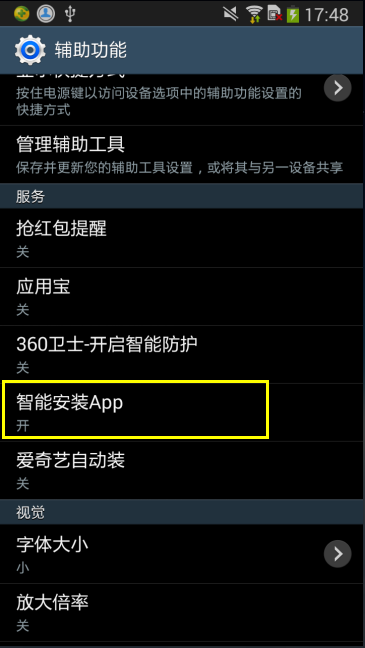
看到了嗎,上面顯示的就是Service裡面的label的值,如果你沒有上面的選項,請檢查AndroidManifest裡面Service的配置.
點擊’智能安裝App’,開啟服務,如下圖:
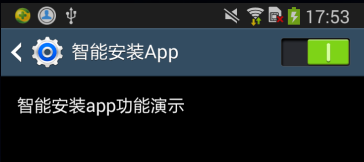
其中的提示文字就是我們在res/xml/accessibility_service_config.xml文件中配置的description屬性
這樣寫完代碼可以運行,點擊按鈕自動安裝sdcard上的test.apk.但是你會發現,所有apk都會自動安裝,這就不符合我們的要求了,我們要求只能通過我們寫的app來自動安裝,其他apk還是要用戶手動去點。怎麼解決這個問題呢?
思路是:在MainActivity中創建一個public static boolean flag,在MyAccessibilityService的onAccessibilityEvent()中加一個flag判斷,然後調用智能安裝前flag設為true,創建apk安裝事件的廣播接收器,當apk安裝完成後,設置falg為false,這樣其他apk就不能自動安裝了,就解決了這個問題
下面上完整代碼.
app/MainActivity.java:
public class MainActivity extends AppCompatActivity implements View.OnClickListener {
private static final String TAG = "[TAG][MainActivity]";
private static final String PACKAGE_NAME = "com.qiyi.video";
private String apkPath = "/mnt/sdcard/test.apk";
public static boolean flag = false;//控制只能自己的app才能執行智能安裝
private TextView tvTest;
private MyInstallReceiver receiver;
@Override
protected void onCreate(Bundle savedInstanceState) {
super.onCreate(savedInstanceState);
setContentView(R.layout.activity_main);
tvTest = (TextView) findViewById(R.id.tv_test);
findViewById(R.id.btn_install).setOnClickListener(this);
findViewById(R.id.btn_uninstall).setOnClickListener(this);
findViewById(R.id.btn_set).setOnClickListener(this);
findViewById(R.id.btn_smart_install).setOnClickListener(this);
//注冊apk安裝監聽
receiver = new MyInstallReceiver();
IntentFilter filter = new IntentFilter();
filter.addAction("android.intent.action.PACKAGE_ADDED");
filter.addAction("android.intent.action.PACKAGE_REMOVED");
filter.addDataScheme("package");
this.registerReceiver(receiver, filter);
}
@Override
public void onClick(View v) {
switch (v.getId()) {
//靜默安裝
case R.id.btn_install:
installSlient();
break;
//靜默卸載
case R.id.btn_uninstall:
uninstallSlient();
break;
//設置無障礙服務
case R.id.btn_set:
//跳轉到開啟無障礙服務的界面
Intent intent = new Intent(Settings.ACTION_ACCESSIBILITY_SETTINGS);
startActivity(intent);
break;
//智能安裝
case R.id.btn_smart_install:
//控制只能自己的app才能智能安裝
flag = true;
smartInstall();
break;
}
}
//靜默安裝
private void installSlient() {
String cmd = "pm install -r /mnt/sdcard/test.apk";
Process process = null;
DataOutputStream os = null;
BufferedReader successResult = null;
BufferedReader errorResult = null;
StringBuilder successMsg = null;
StringBuilder errorMsg = null;
try {
//靜默安裝需要root權限
process = Runtime.getRuntime().exec("su");
os = new DataOutputStream(process.getOutputStream());
os.write(cmd.getBytes());
os.writeBytes("\n");
os.writeBytes("exit\n");
os.flush();
//執行命令
process.waitFor();
//獲取返回結果
successMsg = new StringBuilder();
errorMsg = new StringBuilder();
successResult = new BufferedReader(new InputStreamReader(process.getInputStream()));
errorResult = new BufferedReader(new InputStreamReader(process.getErrorStream()));
String s;
while ((s = successResult.readLine()) != null) {
successMsg.append(s);
}
while ((s = errorResult.readLine()) != null) {
errorMsg.append(s);
}
} catch (Exception e) {
e.printStackTrace();
} finally {
try {
if (os != null) {
os.close();
}
if (process != null) {
process.destroy();
}
if (successResult != null) {
successResult.close();
}
if (errorResult != null) {
errorResult.close();
}
} catch (Exception e) {
e.printStackTrace();
}
}
//顯示結果
tvTest.setText("成功消息:" + successMsg.toString() + "\n" + "錯誤消息: " + errorMsg.toString());
}
//靜默卸載
private void uninstallSlient() {
String cmd = "pm uninstall " + PACKAGE_NAME;
Process process = null;
DataOutputStream os = null;
BufferedReader successResult = null;
BufferedReader errorResult = null;
StringBuilder successMsg = null;
StringBuilder errorMsg = null;
try {
//卸載也需要root權限
process = Runtime.getRuntime().exec("su");
os = new DataOutputStream(process.getOutputStream());
os.write(cmd.getBytes());
os.writeBytes("\n");
os.writeBytes("exit\n");
os.flush();
//執行命令
process.waitFor();
//獲取返回結果
successMsg = new StringBuilder();
errorMsg = new StringBuilder();
successResult = new BufferedReader(new InputStreamReader(process.getInputStream()));
errorResult = new BufferedReader(new InputStreamReader(process.getErrorStream()));
String s;
while ((s = successResult.readLine()) != null) {
successMsg.append(s);
}
while ((s = errorResult.readLine()) != null) {
errorMsg.append(s);
}
} catch (Exception e) {
e.printStackTrace();
} finally {
try {
if (os != null) {
os.close();
}
if (process != null) {
process.destroy();
}
if (successResult != null) {
successResult.close();
}
if (errorResult != null) {
errorResult.close();
}
} catch (Exception e) {
e.printStackTrace();
}
}
//顯示結果
tvTest.setText("成功消息:" + successMsg.toString() + "\n" + "錯誤消息: " + errorMsg.toString());
}
//智能安裝
private void smartInstall() {
Uri uri = Uri.fromFile(new File(apkPath));
Intent localIntent = new Intent(Intent.ACTION_VIEW);
localIntent.setDataAndType(uri, "application/vnd.android.package-archive");
startActivity(localIntent);
}
//監聽apk安裝
private class MyInstallReceiver extends BroadcastReceiver {
@Override
public void onReceive(Context context, Intent intent) {
if (intent.getAction().equals("android.intent.action.PACKAGE_ADDED")) { // install
String packageName = intent.getDataString();
Log.i(TAG, "安裝了 :" + packageName);
//安裝完畢,設置flag,從而使得其余的apk不能自動安裝
flag = false;
}
if (intent.getAction().equals("android.intent.action.PACKAGE_REMOVED")) { // uninstall
String packageName = intent.getDataString();
Log.i(TAG, "卸載了 :" + packageName);
}
}
}
@Override
protected void onDestroy() {
super.onDestroy();
if (receiver != null) {
unregisterReceiver(receiver);
}
}
}
界面上就三個按鈕
res/layout/activity_main.xml:
服務配置文件
res/xml/accessibility_service_config.xml
智能安裝服務
app/MyAccessibilityService.java:
public class MyAccessibilityService extends AccessibilityService {
private static final String TAG = "[TAG]";
private Map handleMap = new HashMap<>();
@Override
public void onAccessibilityEvent(AccessibilityEvent event) {
AccessibilityNodeInfo nodeInfo = event.getSource();
if (nodeInfo != null && MainActivity.flag) {
int eventType = event.getEventType();
if (eventType == AccessibilityEvent.TYPE_WINDOW_CONTENT_CHANGED || eventType == AccessibilityEvent.TYPE_WINDOW_STATE_CHANGED) {
if (handleMap.get(event.getWindowId()) == null) {
boolean handled = iterateNodesAndHandle(nodeInfo);
if (handled) {
handleMap.put(event.getWindowId(), true);
}
}
}
}
}
@Override
public void onInterrupt() {
}
//遍歷節點,模擬點擊安裝按鈕
private boolean iterateNodesAndHandle(AccessibilityNodeInfo nodeInfo) {
if (nodeInfo != null) {
int childCount = nodeInfo.getChildCount();
if ("android.widget.Button".equals(nodeInfo.getClassName())) {
String nodeCotent = nodeInfo.getText().toString();
Log.d(TAG, "content is: " + nodeCotent);
if ("安裝".equals(nodeCotent) || "完成".equals(nodeCotent) || "確定".equals(nodeCotent)) {
nodeInfo.performAction(AccessibilityNodeInfo.ACTION_CLICK);
return true;
}
}
//遇到ScrollView的時候模擬滑動一下
else if ("android.widget.ScrollView".equals(nodeInfo.getClassName())) {
nodeInfo.performAction(AccessibilityNodeInfo.ACTION_SCROLL_FORWARD);
}
for (int i = 0; i < childCount; i++) {
AccessibilityNodeInfo childNodeInfo = nodeInfo.getChild(i);
if (iterateNodesAndHandle(childNodeInfo)) {
return true;
}
}
}
return false;
}
}
最後是配置文件AndroidManifest.xml:
注意:請把自己要安裝的apk放到sdcard上,並且修改代碼中的apk路徑和包名
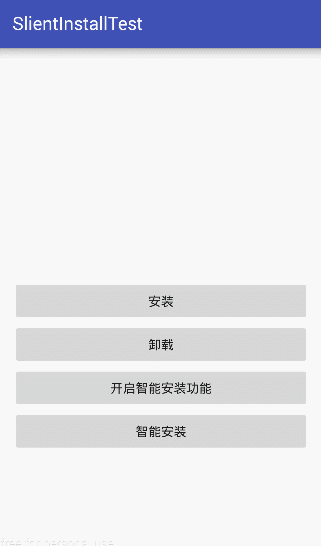
Android智能安裝的原理就是利用了類似鉤子的服務,這個服務還可以用於微信搶紅包的開發,怎麼樣,是不是比ios好玩兒的多呢.
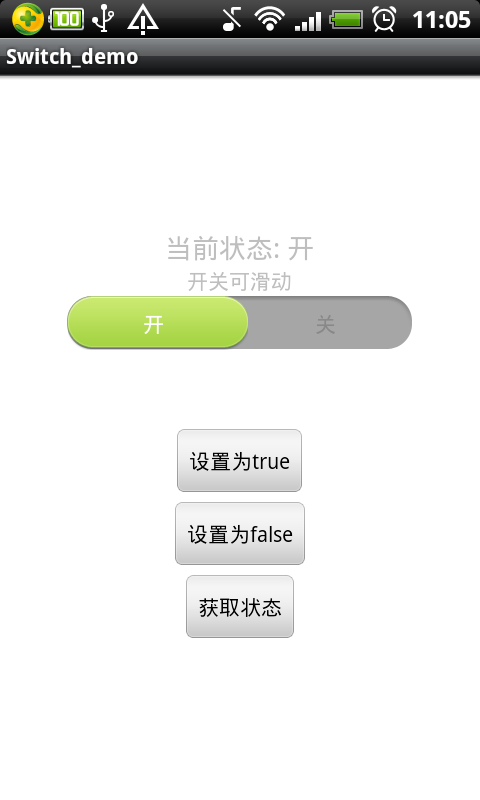 Android編程實現可滑動的開關效果(附demo源碼下載)
Android編程實現可滑動的開關效果(附demo源碼下載)
本文實例講述了Android編程實現可滑動的開關效果。分享給大家供大家參考,具體如下:閒著沒事,把之前寫的一個Demo放上來分享下。就是一個開關,實現可滑動和動畫效果。不
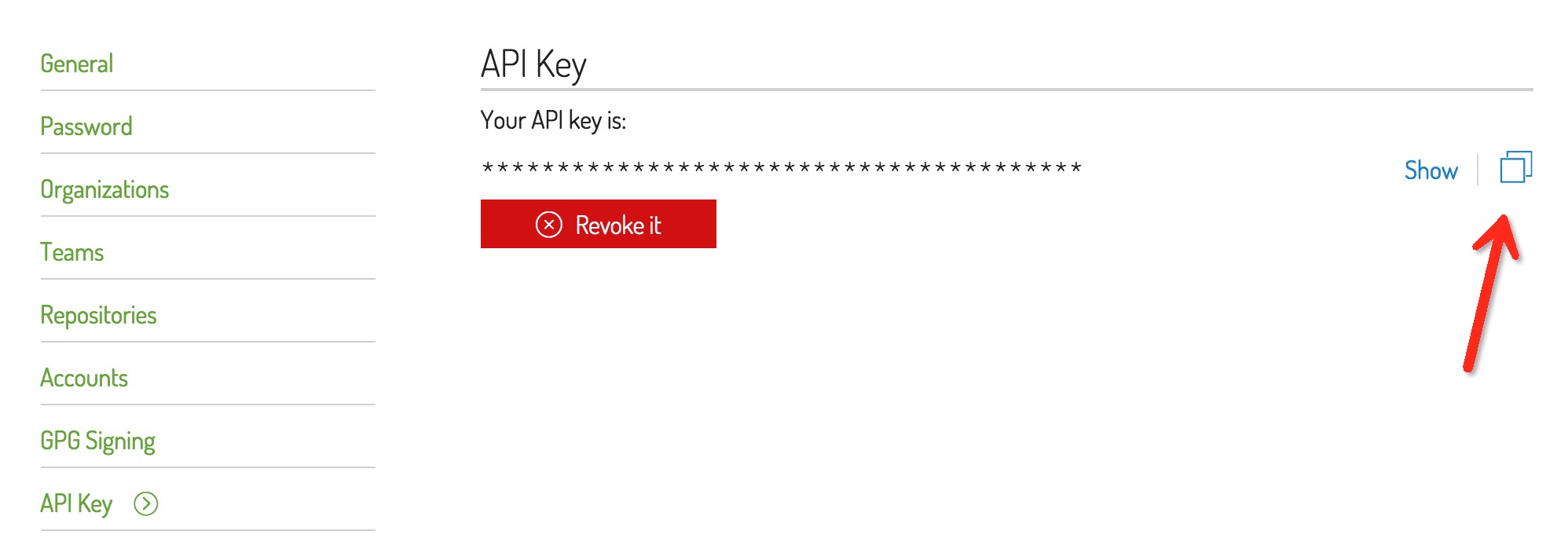 Android - 5分鐘發布Android Library項目到JCenter
Android - 5分鐘發布Android Library項目到JCenter
android-library-publish-to-jcenter是一個幫助Android開發者將AAR庫發布到jcenter的項目,android-library-p
 【源碼分析】Android系統啟動流程
【源碼分析】Android系統啟動流程
Android的啟動過程是從init開始的,它是所有後續進程的祖進程。系統啟動的過程可以大致分為以下幾個步驟1,init.c的啟動 掛載目錄 初始化 解析配置文件2
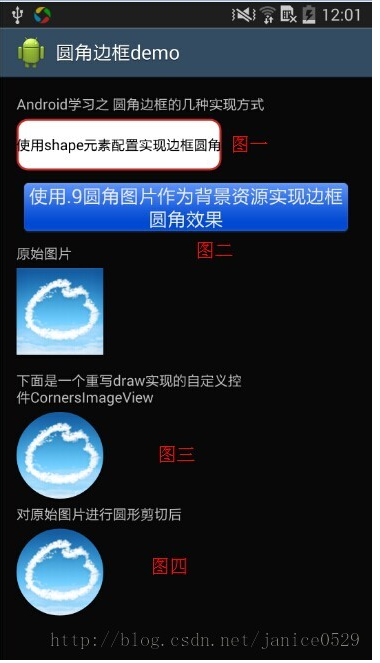 Android 圓角邊框的實現方式匯總
Android 圓角邊框的實現方式匯總
首先我將貼出幾種實現圓角邊框的dmeo程序效果圖:方式一:使用shape元素填充背景,設置圓角/帶弧度的角1、首先在 \res\drawable下新建Shape為根元素的